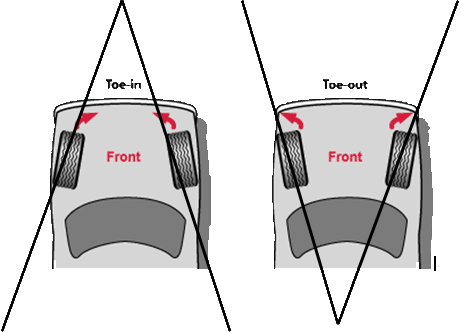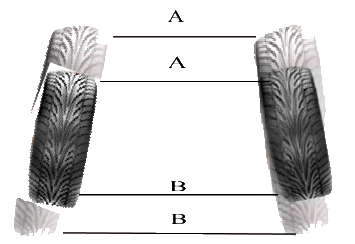 Wheel Toe-In and Toe-Out Theory Wheel Toe-In and Toe-Out Theory
Definition
Wheel toe-in is an angle formed by the centre line of the wheel and the longitudinal axis of the vehicle, looking at the vehicle from above, the sum of the toe values for each wheel gives the total toe value,
When the extensions of the wheel centre lines tend to meet in front of the direction of travel of the vehicle, this is known as toe-in A, If, however the lines tend to meet behind the direction of travel of the vehicle, this is known as toe-out B,

When the extensions of the wheel centre lines are parallel, this is known as zero position, the toe value is rarely given in degrees by the manufacturer, and it is common to give a value expressed in mm which measures the difference in mm between circles in the wheels the two measurements are taken in front of and behind the wheel hub, at a distance from the ground halfway up the wheel,
Measurements
When the toe-in / out is measured in degrees (as an angle), the diameter of the wheel circle must be taken into account, with the value being inserted at intervals,

The wheel toe-in/ out given by the difference (A-B) is evidently greater in the 16” circle than the 10” circle,
The wheel toe-in/ out value set by the manufacturer is such that, when travelling under average vehicle use conditions, it goes to a value near to 0 degree,
In fact, under the effect of load, that deforms the suspension parallelograms, the effect of engine thrust that may or may not be applied to the wheels in question and the effect of the vehicle travel resistance from the road, the toe-in/ out can undergo large-scale variations,
Effect of load on toe-in / out
In the chapter which deals with wheel camber, the behaviour of the suspension parallelogram under load is described and, when the parallelogram is deformed it produces angular variations in the wheel and kingpin,
As these variations are based on the positioning of the kingpin, with it’s characteristic inclination and castor angles, it occurs in some types of suspension systems that movements in the suspension cause quite notable variations in the toe-in/ out value,
Another variation to the toe-in/ out value can be caused by the track rods in relation to the wheels, the vertical movement in relation to the chassis is followed by the track rods which, providing the movement is allowed by the joints, follow circumference arcs with a radius equal to their length,
The different available cases vary in that the track rods and suspension arms are normally of equal length and with different point of application, which vary from vehicle to vehicle,
In fact, there are many different types of steering parallelograms due to the large number of different solutions adopted by the manufacturers, because of this, it is not possible to have an accurate rule about toe-in/ out variations in relation to load.
|